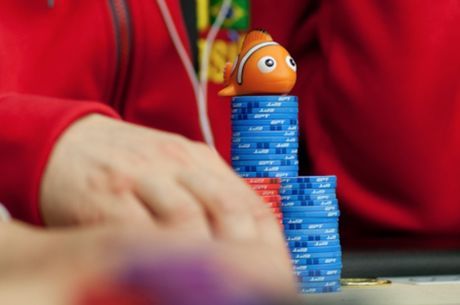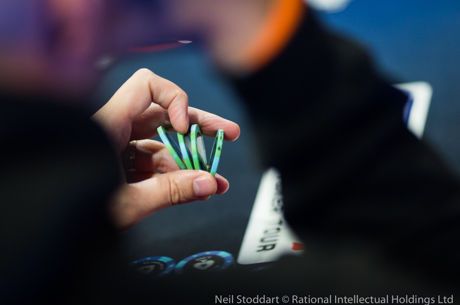His and Hers Poker: A Precision Strike With Ideal Bet Sizing

Greetings, Poker Friends! This week we are going to focus on how you can use bet sizing to accomplish precise goals.
The Table and Villain(s)
We're back at a $2/$5 table at the Borgata. The table is full of loose-passive players, with one notable exception.
The primary Villain for this hand is in the second middle position seat, a reg in her early 30s. Hero (Matt) and the Villain have an extensive history (in fact, she has already featured as the Villain in a prior hand on our podcast). She is a notably aggressive player who can dominate passive tables. However, she will sometimes go a bit too far. She will often take what is a perfectly fine showdown value hand and turn it into a bluff if she senses weakness. Villain knows that Hero is a thinking, aggressive player who attempts to maintain balanced play.
Effective Stacks: ~$850 (Villain).
Preflop
Action
Four players limp, including the Villain from her spot in middle position. Hero is in the small blind and looks down to find A?Q? and raises to $40. The Villain is the only caller and we go heads-up to the flop.
Analysis
The ideal situation for preflop bet sizing is to be able to bet the same amount with the entire range of hands which you are opening from a given position. That way, your bet sizing does not reveal anything about your holding. At a loose low-stakes table, however, an exploitative adjustment can be useful. We can tailor our bet size to get the hand as multi-way (or not) as our particular holding would prefer.
With a strong drawing holding like a small pocket pair or a suited connector, we can open something like $30 to set up a multi-way hand with a better chance of someone being able to pay us off if we hit our draw. With a pure high card holding, we can open around $55 to create a less multi-way hand where we stand a better chance of having the winner when we flop top pair.
Our hand �� A?Q? �� is somewhere in between these two options, being a high card holding which is also suited and a one-gapper. This leads to the selected bet size of $40. Again, this sizing shift is fairly transparent and exploitable, but only if someone is paying attention and will make the effort to punish it. At a highly passive low stakes table, this unlikely risk is often outweighed by the benefits.
Flop
Action
The flop comes Q?8?3?. Hero bets $55 into the pot of $100. Villain calls.
Analysis
Now that we are heads-up with a competent opponent, we should (at least on the flop) revert back to a balanced style of bet sizing. That means betting in accordance with the flop texture rather than based upon our actual holding. This flop is more toward the dry end of the spectrum, but not totally bone dry. That should lead us to bet somewhere around half-pot, hence the sizing of $55 here.
Turn
Action
With $210 in the pot, the turn brings the Q? for a board of Q?8?3?Q?. Hero bets $110. Villain calls.
Analysis
On the turn, we can start to get more exploitative with our bet sizing. Here, multiple competing interests tug our bet sizing in different directions. In one scenario, if Villain has the case queen, she will call us for a huge sizing. On the other hand, if Villain has a flush draw, there is some bet sizing where she will decline to continue. Finally, if Villain has a mid-range pair, she may not even call us for a half-pot bet.
The trick is, we'd like to get value out of all of these holdings. Some players will "put her on a queen" and blast off with a huge bet sizing. However, that is blindness caused by greed. With only one queen unaccounted for, that is Villain's least likely holding. Taken as a whole, Villain's range cannot bear the brunt of a massive bet. A more reasonable sizing is warranted, likely somewhere in the same half-pot vicinity.
River
Action
With a pot of $430, the river is the 6?. The final board is Q?8?3?Q?6?. Hero looks to Villain's remaining stack and sees she has approximately $650 left. Hero bets $275. Villain thinks for a little while and then makes the call. Hero shows his A?Q? and Villain mucks her hand.
Analysis
The river is where we can really use bet sizing to accomplish a specific goal based upon our opponent. Against a passive opponent, a small bet would likely be in order here. Somewhere on the order of $200. That is likely the maximum value we can get from something like Qx9x-suited which limp-called preflop. Maximizing value is really the one and only goal against a passive opponent. We don't have to worry about getting bluffed off of our trips because we can rest assured that we are only getting raised by a flush.
In the hand in question, however, we are against a highly aggressive Villain. If we bet $200, an aggressive opponent will likely read that for exactly what it is: a thin value bet with a queen. Such an opponent will very likely opt to turn some of their mid-range holdings (particularly those with a club blocker) into a bluff, making our life miserable.
So, what do we do? Against a balanced, aggressive opponent with a large stack, I would likely put out a bet of around $325. That's a sizing which doesn't tip our holding. We could use it with our entire value-heavy range. It also discourages a bluff-raise, since it would need to be a full shove for proper fold equity. Even aggressive opponents at $2/$5 are hesitant to stick in four figures on a bluff. Therefore, we could comfortably suspect that any raise was with a flush.
Against this particular Villain, however, we could do something even more interesting. We could check to induce a bluff. Many opponents, even aggressive ones, would just check back their mid-range showdown value holdings. However, we have seen a tendency for this Villain to turn such hands into bluffs when sensing weakness.
If Villain had $1,000 in her stack, a check would be an interesting move. However, as the case stands, a check may be unwise. If Villain had $1,000 behind, she would probably bluff around $300, a sizing which we could comfortably call off. With only $650 left, however, she may well opt to shove with her entire range. That leaves us in a sick spot which we'd rather avoid. Let's see if we can craft a better solution.
If we bet something like $275, this thinking Villain will know that putting in an additional $375 will not generate enough fold equity to get us off of a queen. She will likely concede the point and fold most of her mid-range holdings, call us with her queens, and shove her flushes. We have found the point where we can maneuver Villain into the most easily readable action for the lowest price and still get good value to boot.
The Takeaway
Bet sizing is not the flashiest topic to study, but it is incredibly important to master since it affects every single hand you play. Don't just put out a randomly sized bet. Against exploitable opponents, use your bet sizing to accomplish specific goals and maneuver them into taking transparent actions.
His and Hers Poker is a free, weekly strategy podcast hosted by Matt and Tracey Waldt. They are a married couple who play live cash games on the East Coast. Their podcast focuses on providing practical advice about hand reading, with an emphasis on how to identify and exploit the common leaks and imbalances of low-stakes players. His and Hers Poker can be found on iTunes, Google Play and other podcast services. For more information, and to subscribe, please visit hisandherspoker.com.









